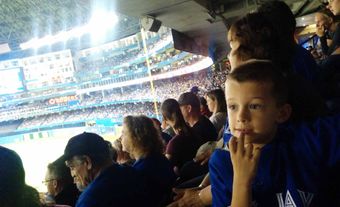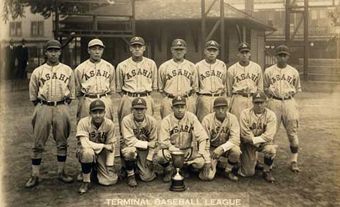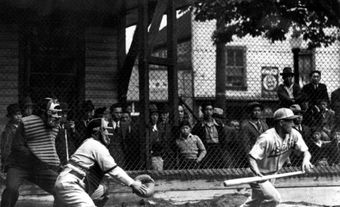
The first Canadian team admitted to baseball's National League, the Montreal Expos began playing in 1969 at Jarry Park in Montréal's north end. In 1977, the Expos moved to Olympic Stadium, where they played through the 2004 season, after which the team was relocated to Washington, DC, and renamed the Washington Nationals. The Expos won the East Division title in 1981.
Early History of Baseball in Montréal
Baseball has had a long tradition in Montréal and the province of Québec. The sport has its roots in earlier “bat and ball” games that were played in many European countries, including France and England, and in their colonies. Contemporary baseball and cricket are the two surviving forms of these early games; both had become popular in Montréal by about the middle of the 19th century. Cricket was played as early as 1785 on Île Sainte-Hélène, an island near Montréal. A game similar to contemporary baseball may have been played in Québec in 1837, as there is a reference to a “game of ball” in background notes compiled by Robert Sellar, who wrote The History of the County of Huntingdon [Quebec] and of the seigniories of Chateaugay and Beauharnois from their First Settlement to the Year 1838. The clearest evidence of baseball in Québec comes from the mid-19th century. According to an article in the New York Clipper from 1 September 1860, Montréal had a formal baseball club, the Excelsior, led by President Alex McIntosh, that practiced “just above the ground of the Montreal Cricket Club.”
The sport also began to gain popularity among the French-speaking population around that time. Baseball was introduced into francophone communities in the Montréal region by Franco-American students who had come to study at Québec colleges. These students were the children of expatriate Quebecers who had left the province for work in New England, where baseball was already popular. When these parents realized their children were losing their cultural heritage, they sent them to Québec for post-secondary education. By the early 1870s, the sport was increasing in popularity, with games being played between the Sainte-Marie and Saint-Laurent colleges. In 1873, Club Jacques Cartier was established — the first francophone baseball club in Montréal. By the end of the 19th century, there were amateur leagues in both the city and elsewhere in the province.
In 1897, professional baseball came to Montréal, when a team from the minor leagues was relocated from Rochester, New York. Eventually known as the Royals or “Royaux,” the team played until 1917, when it was ejected from the league. However, it was revived in 1928 and became an affiliate (or farm team) for the Brooklyn Dodgers in 1939. Probably the most famous of the Montreal Royals was Jackie Robinson, who in 1946 became the first Black player in the modern minor leagues. The team also has a connection with Canadian political “royalty.” Charles-Émile Trudeau, father of Pierre Trudeau and grandfather of Justin Trudeau, was a wealthy businessman who invested heavily in the Montreal Royals baseball team; he became a member of the board of directors and eventually vice-president of the team. In 1935, Trudeau died while attending the Royals spring training camp in Florida. The headline in La Patrie read “Le baseball perd un apôtre en M. Trudeau” (“Baseball loses an apostle in Monsieur Trudeau”).
The Montréal Expos
In 1967, Montréal bid for a franchise in the National League, part of an expansion of Major League Baseball that added four teams. One of the main proponents was Montréal mayor Jean Drapeau, who also played a key role in building the Montréal Metro and in bringing both Expo 67 and the 1976 Olympic Summer Games to the city. The bid also received support from Walter O’Malley, the American owner of the Los Angeles Dodgers (the team had moved from Brooklyn following the 1957 season), who was part of the league’s expansion committee. O’Malley was impressed by the size of Montréal, as well as the city’s long interest in baseball. He also had fond memories of the city’s support for his farm team, the Montreal Royals, particularly the warmth shown by Montréal fans for Jackie Robinson, who in 1946 became the first African American to play in the modern International League (he went on play with Brooklyn the next year). In 1968, the Montréal expansion franchise was announced by the National League.
The new Montréal team was named in honour of the 1967 world exhibition, more commonly known as Expo 67. Under the majority ownership of Seagram’s distillery president Charles Bronfman, and the presidency of John McHale, the early teams had sparkling successes. In 1969, their inaugural season, the Expos won their first regular season game 11–10 against eventual World Series champion New York Mets. In only the ninth game of the season, Bill Stoneman tossed a no-hitter, one of the two he would eventually pitch for the Expos.
Jarry Park Era
The first Expos teams played at the diminutive Jarry Park in Montréal’s north end — a temporary location until a new stadium could be built. Once an amateur ballpark for 3,000 spectators, it was brought up to major league standards with a seating capacity just under 30,000. Expos players and fans enjoyed the intimate dimensions of their stadium, in which vendors tossed peanuts and a fiddler played on the dugout roof, and beer was sold in the stands. The stadium announcer’s introduction of players like catcher John Boccabella, was rolled out syllable by syllable to the rising expectation of fans. The dual language announcements of le frappeur (batter), le lanceur (pitcher), and la manche (inning) mystified many American commentators while ensuring the team was a hit with both its French and English language patrons.
Crowd favourites from the Jarry Park era included memorable players such as Rusty Staub, whose striking red hair, and his desire to learn French, earned him the sobriquet “Le Grand Orange.” In two of three seasons with the Expos (1969–71), Staub batted over .300, thus bringing instant credibility to the team. Two of the team’s premier recruits in the 1970s, Gary Carter (1974–84; 1992) and Andre Dawson (1976–86), were inducted to the National Baseball Hall of Fame as Expos. Another Expo player, Felipe Alou (1973), would later become team manager (1992–2001).
Move to Olympic Stadium
In 1977, the team moved to the Olympic Stadium, a 66,308-seat venue built for the previous year’s Olympic Summer Games. What was lost in intimacy was replaced by the team’s rising on-field prominence as talented players emerged from their draft choices and player development system. Around two million fans annually packed the Olympic Stadium, or “Big O” as it was known, in the late 1970s and early 1980s as the team became a perennial contender. Heartbreak followed, however, as the team lost pennant races in 1979 to the Pittsburgh Pirates and in 1980 to the Philadelphia Phillies.

In 1981, the Expos defeated the Phillies to win the East Division title. However, in the National League playoffs against the Los Angeles Dodgers, they reached the deciding fifth game but were deprived by a ninth inning home run off the bat of Rick Monday. It’s a day immortalized in Expos lore as “Blue Monday.” The Dodgers would go on to win the World Series.
The Expos trajectory was one of declining fortunes for much of the remaining 1980s, as they gradually lost or traded away the nucleus of their 1979 to 1981 teams. They did retain Tim Raines, a lead-off hitter (career batting average .294) and base-stealer extraordinaire (5th on the all-time list with 808); Raines played 12 seasons in Montréal (1979–90), during which he made the National League’s all-star team seven consecutive times. Despite his contributions, the Expos struggled through the 1980s and the crowds fell.
The 1990s
The Expos would be rejuvenated in the early 1990s by a new generation of players emerging through superb draft choices and player development. One of Canada’s all-time greatest players, Larry Walker, starred for the team in the early 1990s (1989–94), as did Moisés Alou (1992–96), son of team manager — and former player — Felipe Alou. Other notable players from the period include Dennis Martinez (1986–93), who threw a perfect game (all 27 batters retired without reaching base) for the Expos against the Los Angeles Dodgers in 1991.
In 1994, the Expos seemed destined for the playoffs. However, as in 1981, when the season was shortened by a labour dispute, the Expos were again affected by a disagreement between players and owners. Labour trouble brought the season to a halt in August, at which point the Expos led their division by six games and were favoured by many to finally reach the World Series. The season never resumed, and their second chance at the championship was lost.
Several of their best players, including Larry Walker, entered free agency or were traded after the bitterness of the 1994 season. While still a formidable squad, the Expos’ future pennant hunts were frustrated by the tightfistedness of their owners, who were reluctant to provide them with the necessary resources for taking on additional salaries.
Changes in ownership played a significant part in the team’s declining fortunes. In 1991, Charles Bronfman sold the team to a purchasing consortium of Canadian investors, who were unwilling to put much money into the team. The troubles were fed by a declining Canadian currency at a time when free agency contracts were escalating and contracts were always paid out in American dollars. In 1997, the club presented a plan for a downtown 35,000-seat ballpark (dubbed Labatt Park) with features resembling the popular retro parks, like Baltimore’s Camden Yards, that were springing up in the United States. The plan called for funding from both private and public sources, including the provincial government. Although the opening date was scheduled for 2001, the new stadium never materialized; while finance minister Bernard Landry supported the plan, the premier of Québec, Lucien Bouchard, said the government wouldn’t fund stadiums when it was forced to close hospitals. All the while a talented young right fielder,Vladimir Guerrero, began his spectacular career as an Expo (1996–2003) before moving on to the Anaheim Angels.

American Ownership and Relocation
New American ownership under Jeffrey Loria assumed a minority interest in 1999 which gradually became a majority position as cash calls to Canadian partners went unanswered. They had declining interest in keeping the team in Montréal and talk began about relocating the team to another city. At the same time, Major League Baseball (MLB) announced its own plan to cut two teams from the National League, one of which would have been the Expos. In 2002, MLB assumed ownership of the team after they bought it from Loria for US$120 million and a US$38.5 million interest-free loan.
It was a painful last few seasons for the Expos, as their departure from the city seemed inevitable. Claude Raymond, a Québec-born pitcher in the early Expos, and a team coach in the final seasons, recalled going out to the mound after the team’s last home game on 29 September 2004 and throwing a final, symbolic pitch: “I stayed on the diamond until everyone left,” he told Pierre Durocher of Journal de Montréal in 2014. “I went to the mound and I wanted to make one last pitch." The Expos were relocated to Washington, DC, and renamed the Washington Nationals.
Will the Expos Ever Return?
Talk occasionally surfaces about Major League Baseball returning to Montréal. The Toronto Blue Jays have supported this cause by playing several spring training exhibition games in the “Big O” (Montreal’s Olympic Stadium), beginning in 2014. The Jays had entered the American League as an expansion team in 1977. Their rise in the early 1980s, culminating in two World Series triumphs in 1992 and 1993, paralleled the Expos’ years of frustration. For a number of seasons (beginning in 1978) the two teams met in an annual Pearson Cup exhibition game during the regular season. Named after Prime Minister Lester B. Pearson, himself a great baseball fan, the Cup was retired after the 1986 season when scheduling proved impossible. It was revived in 2003 as a six-game interleague series between the two teams; in both 2003 and 2004 the Jays and Expos tied the series. The two teams last met on 4 July 2004 in Puerto Rico, where the Expos played many of their 2004 season games in an effort to increase revenues.
Hall of Famers
|
Name
|
Position | Tenure with Expos | Inducted |
| Tony Pérez | 1st Baseman | 1977–79 | 2000 |
| Gary Carter | Catcher | 1974–84; 1992 | 2003 |
| Dick Williams | Manager | 1977–1981 | 2008 |
| Andre Dawson | Right Fielder | 1976–86 | 2010 |
| Randy Johnson | Pitcher | 1988–89 | 2015 |
| Pedro Martinez | Pitcher | 1994–97 | 2015 |
| Tim Raines | Left Fielder | 1979-90 | 2017 |
| Vladimir Guerrero | Right Fielder | 1996-2003 | 2018 |

 Share on Facebook
Share on Facebook Share on X
Share on X Share by Email
Share by Email Share on Google Classroom
Share on Google Classroom




